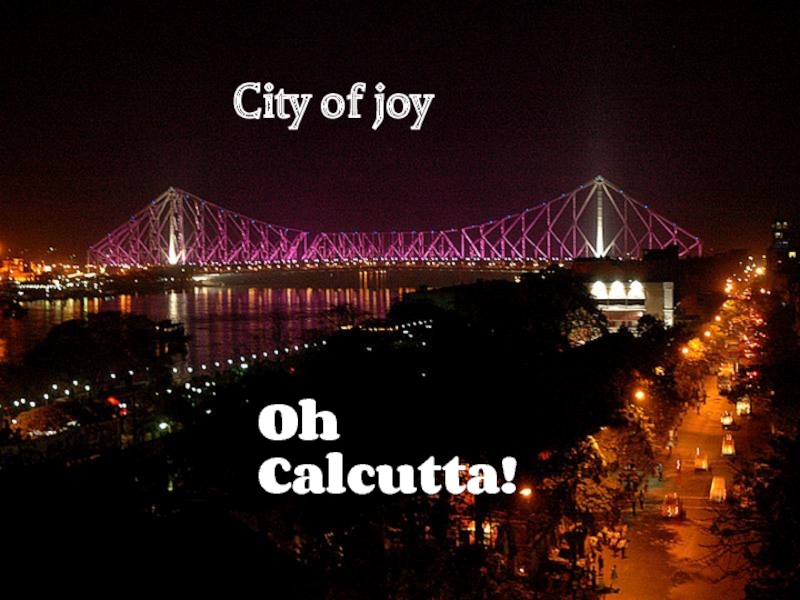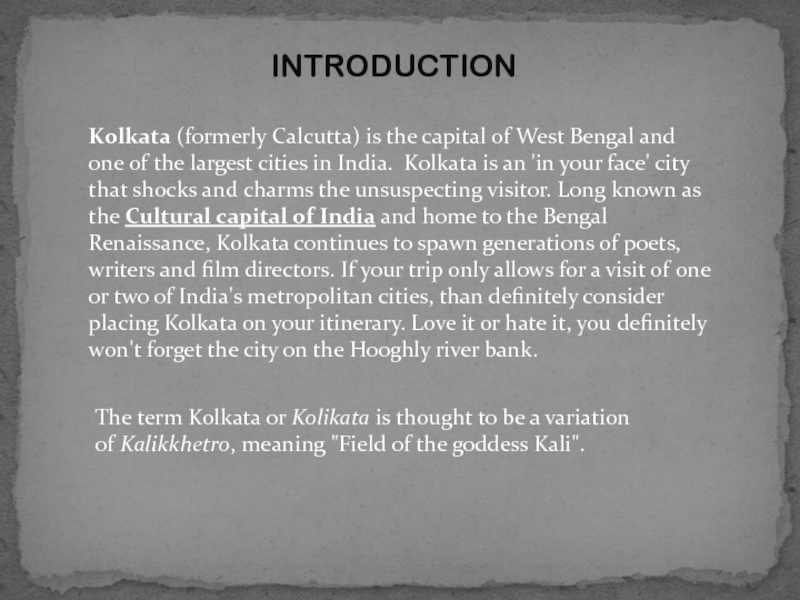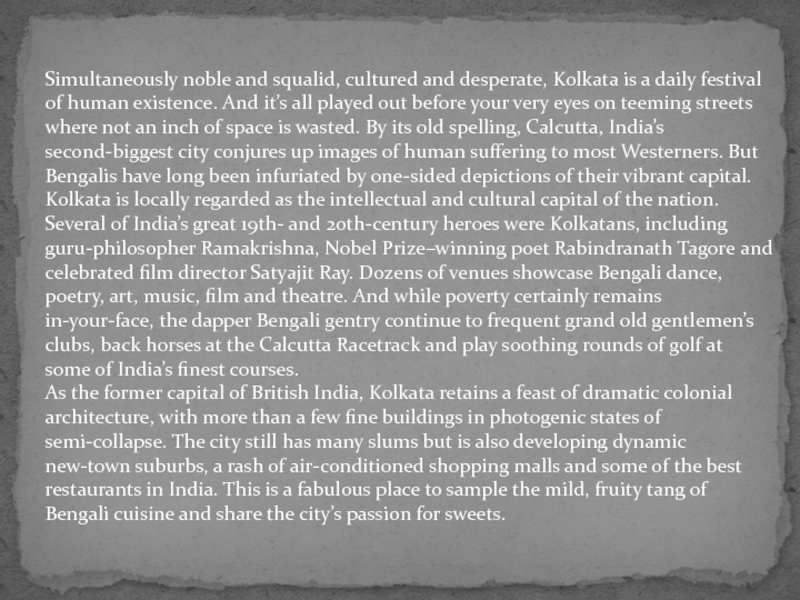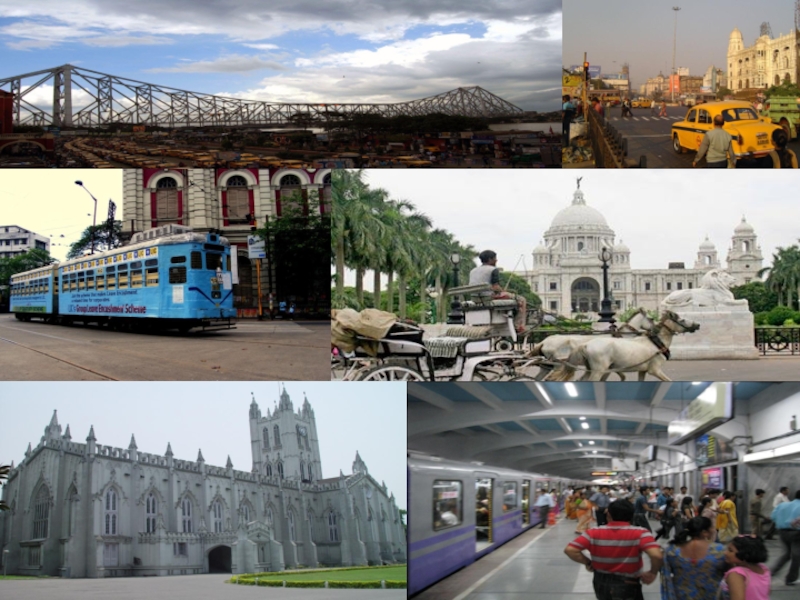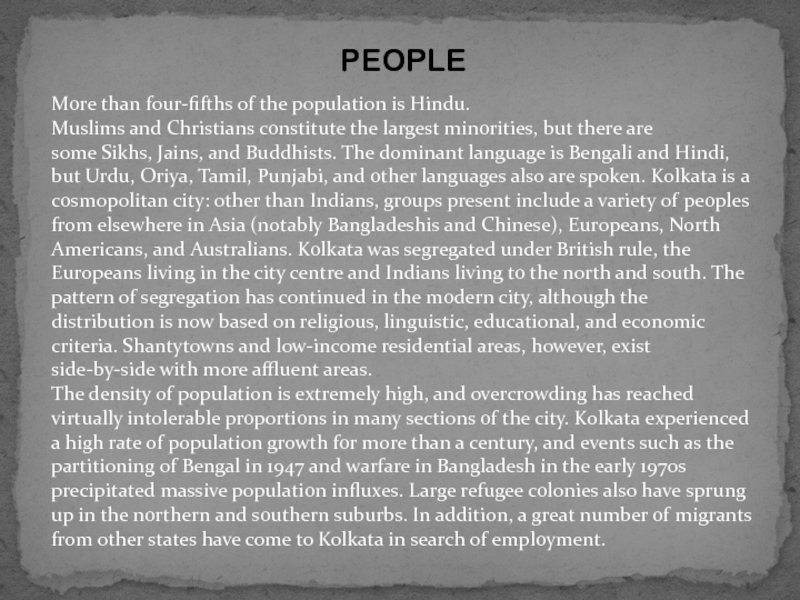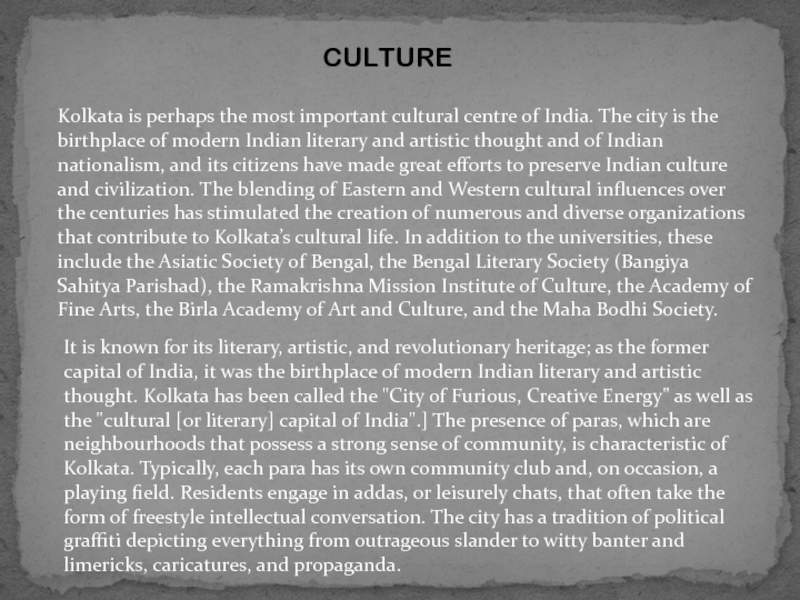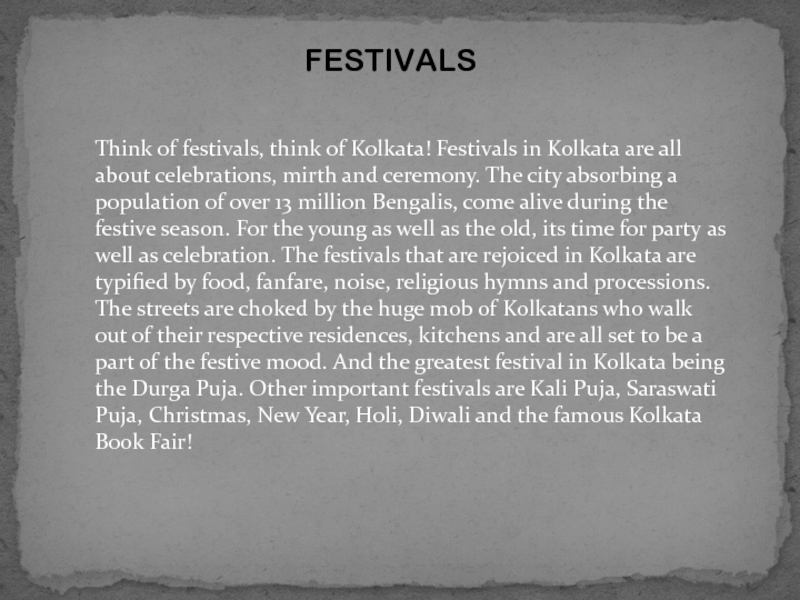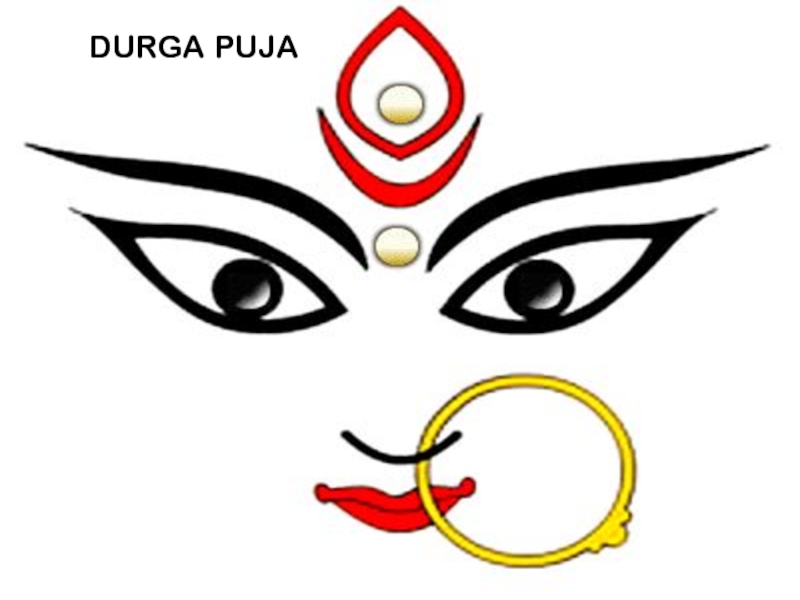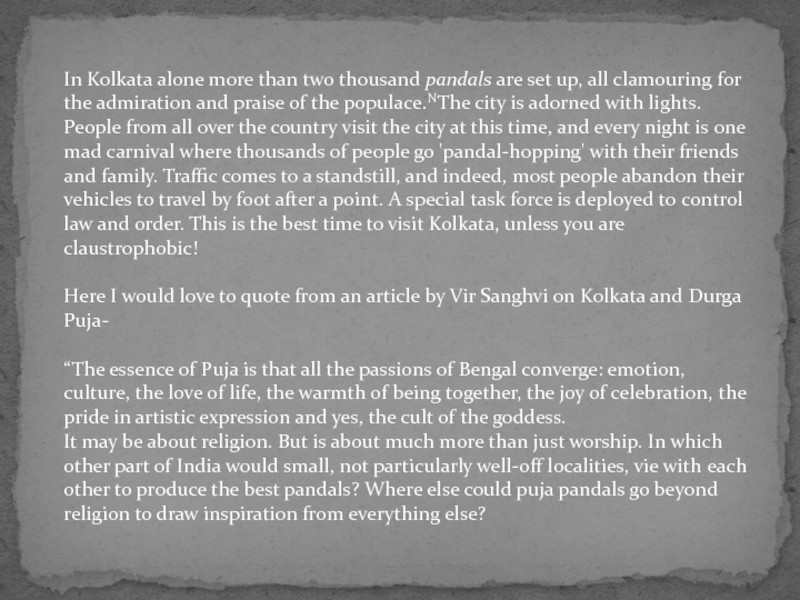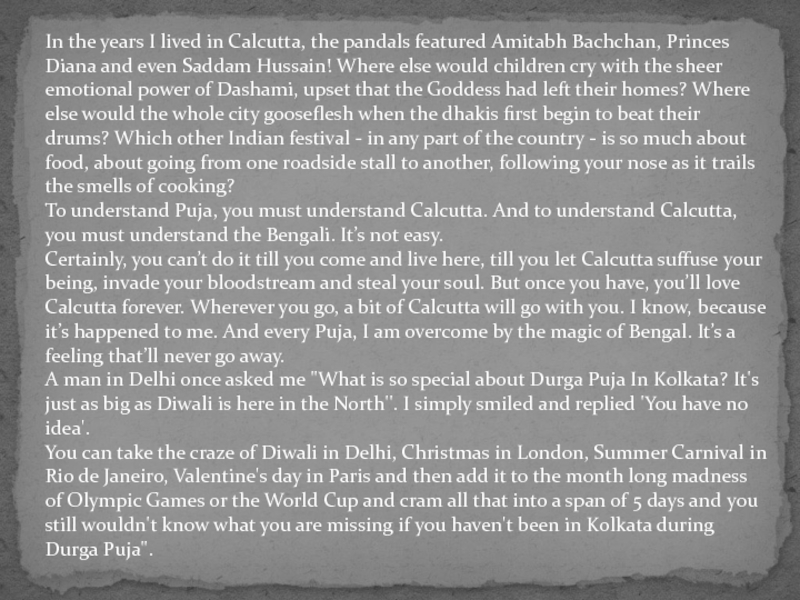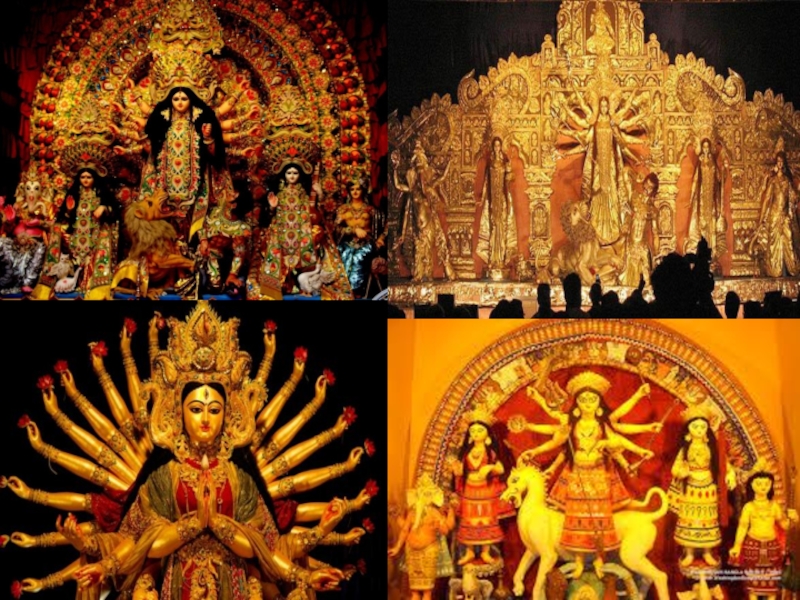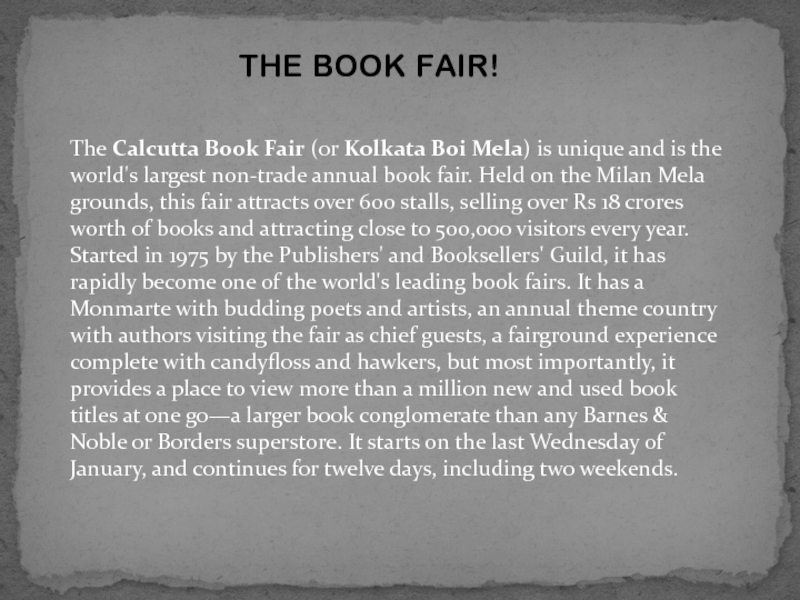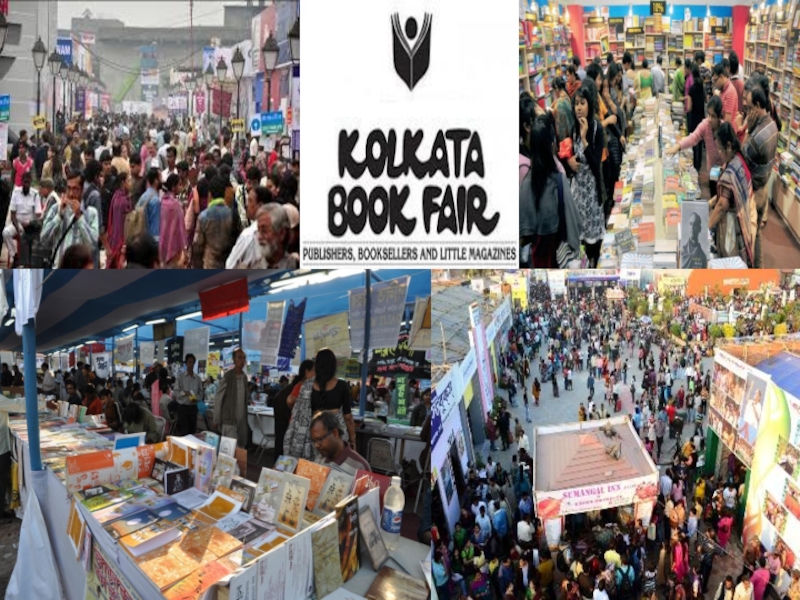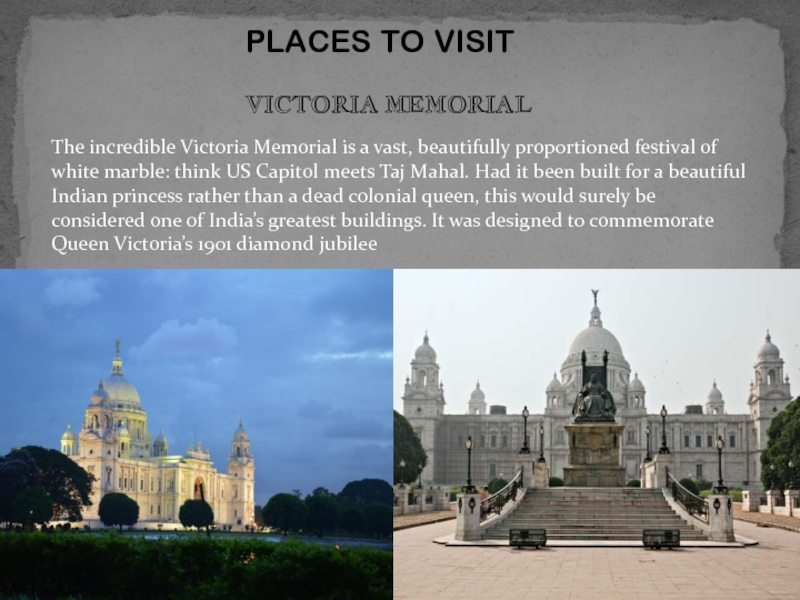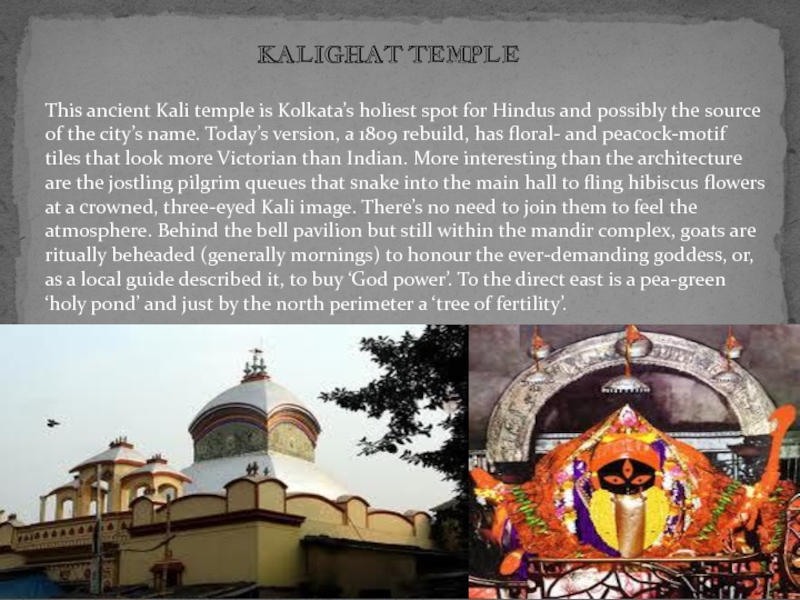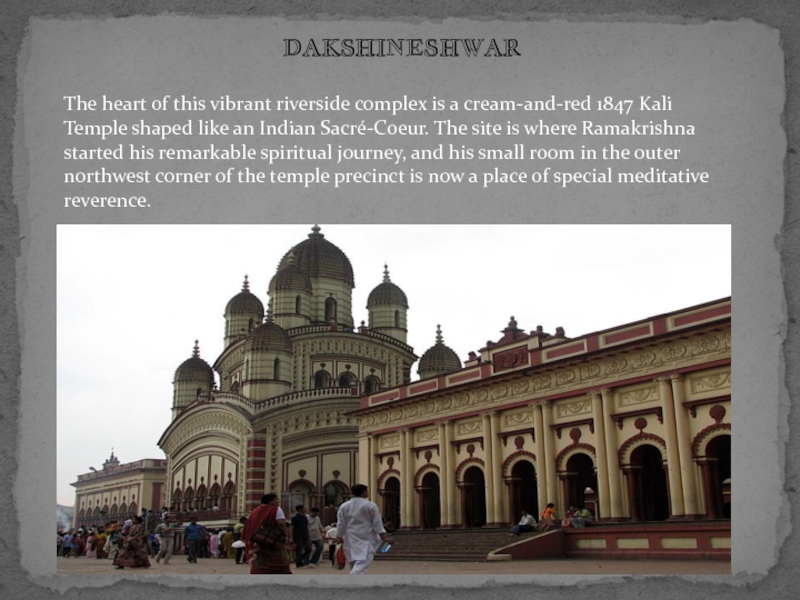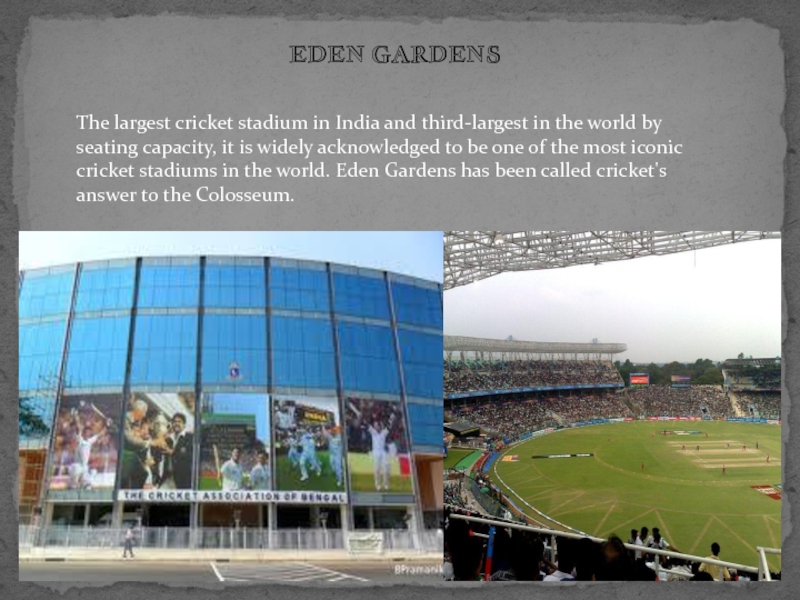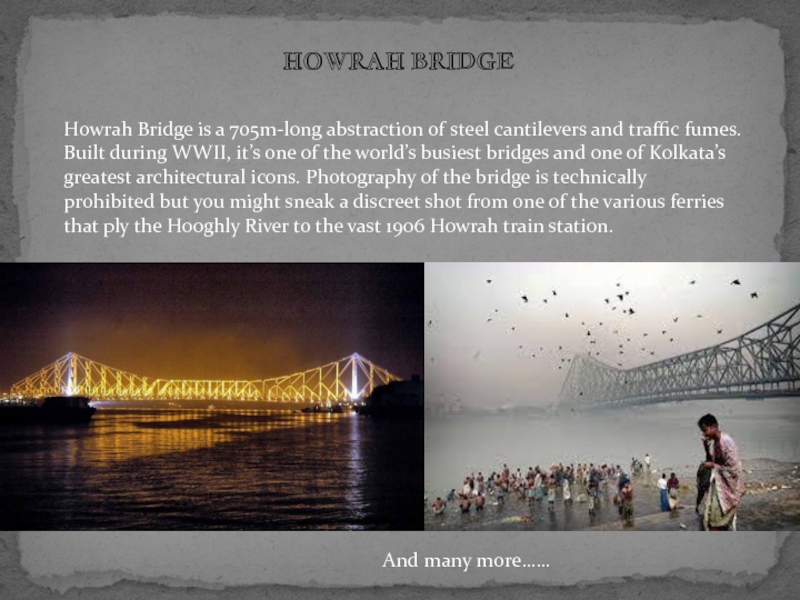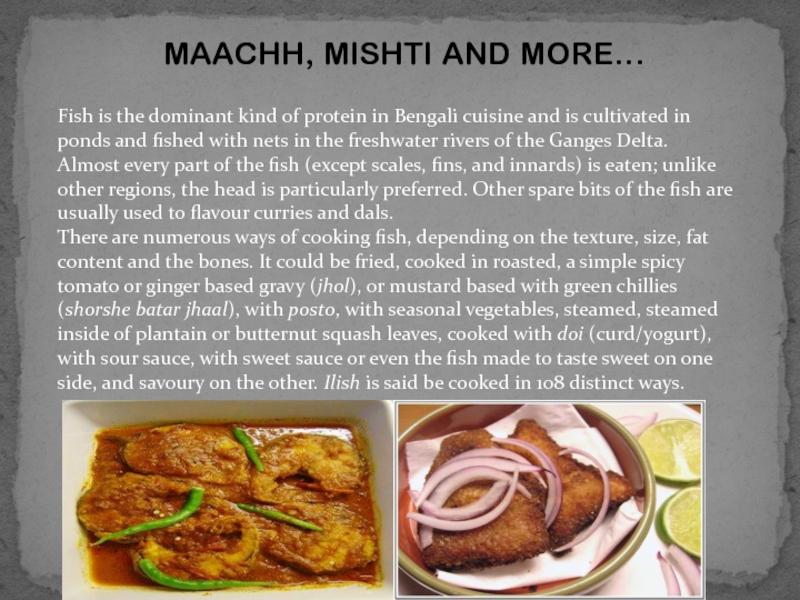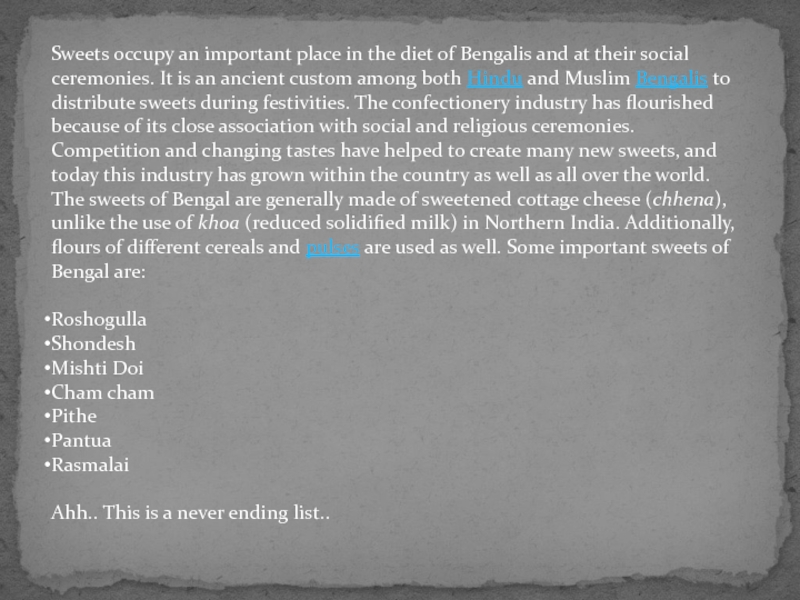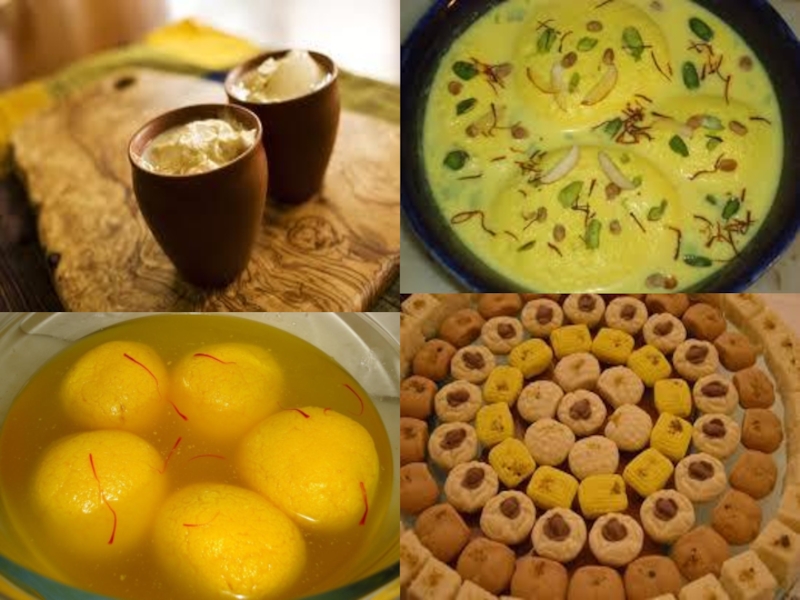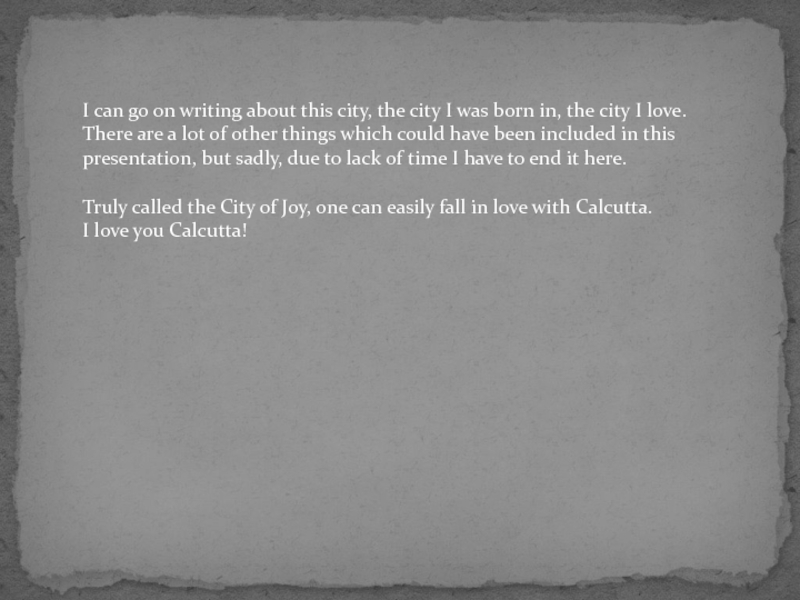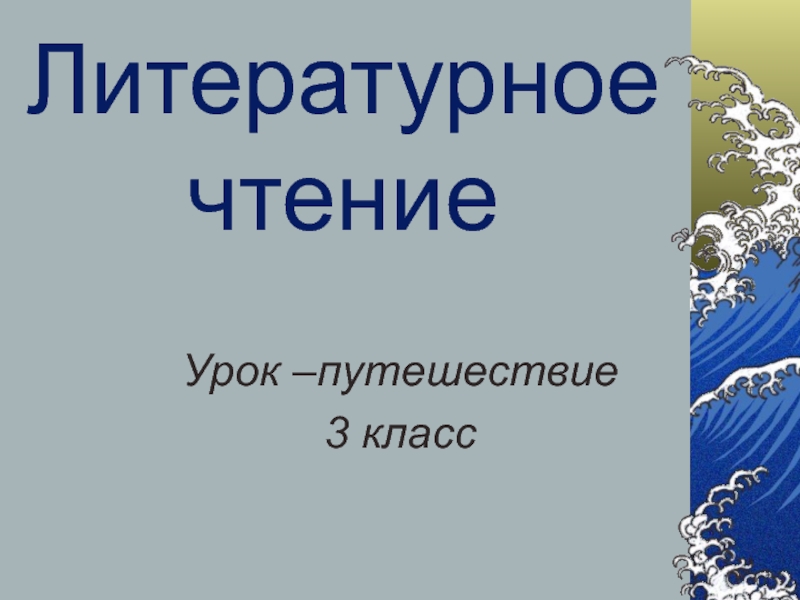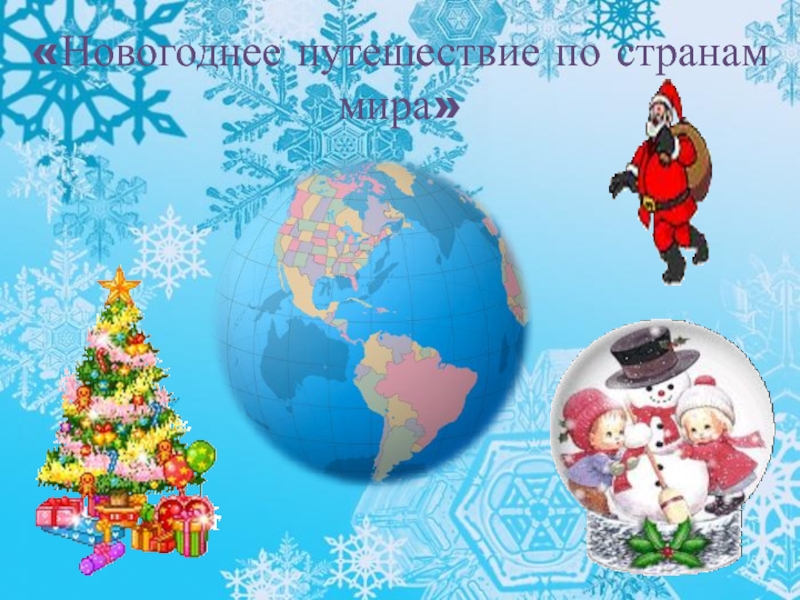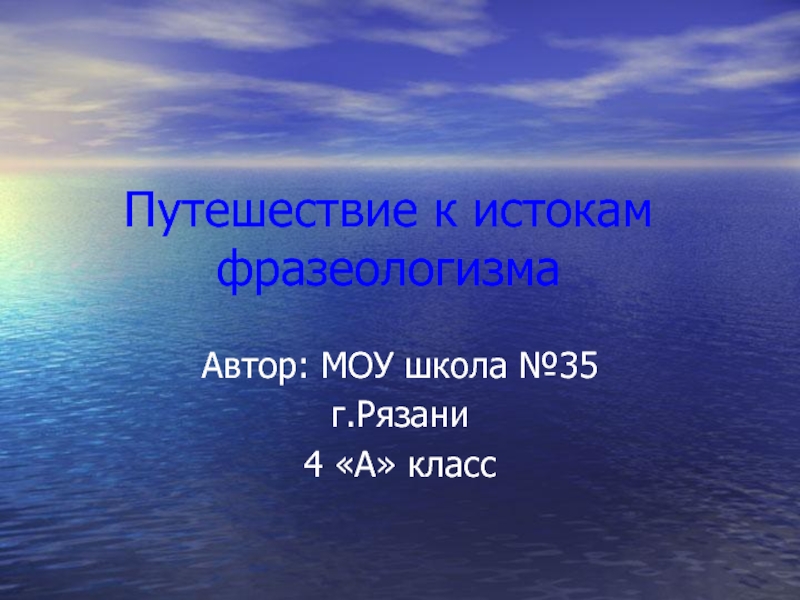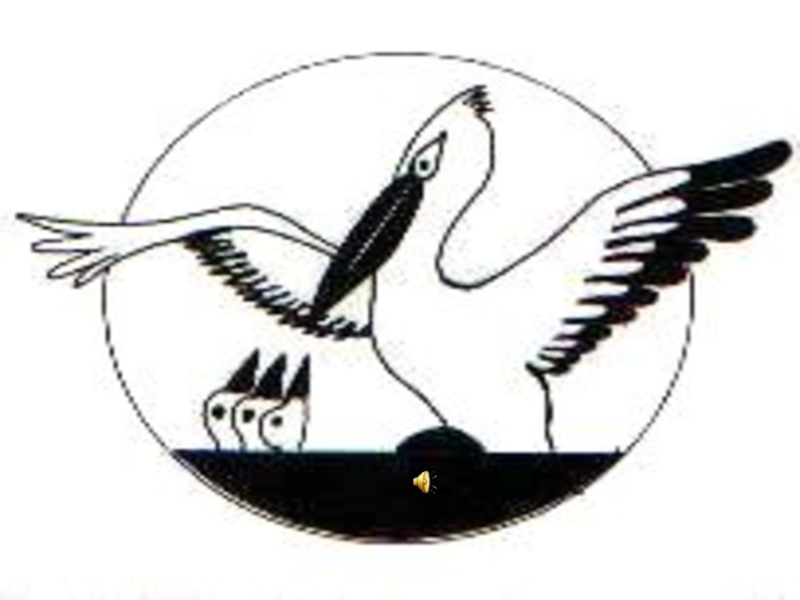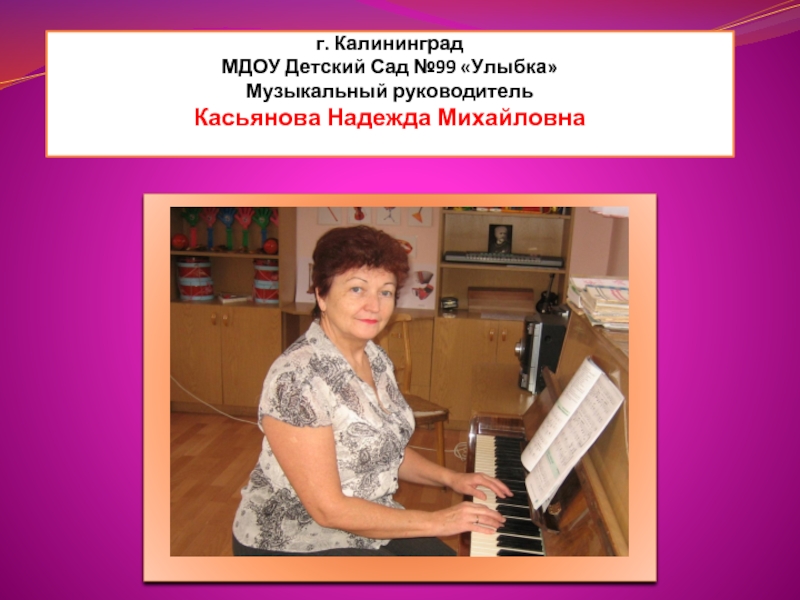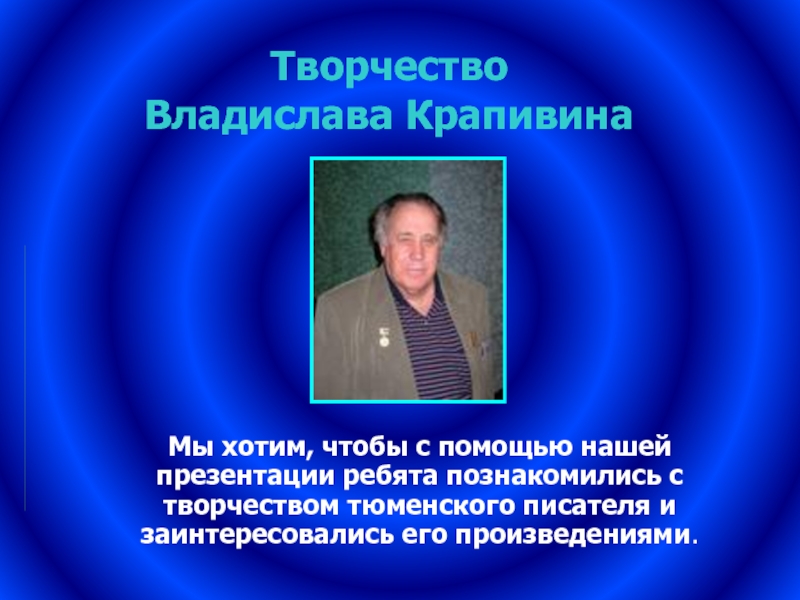- Главная
- Разное
- Дизайн
- Бизнес и предпринимательство
- Аналитика
- Образование
- Развлечения
- Красота и здоровье
- Финансы
- Государство
- Путешествия
- Спорт
- Недвижимость
- Армия
- Графика
- Культурология
- Еда и кулинария
- Лингвистика
- Английский язык
- Астрономия
- Алгебра
- Биология
- География
- Детские презентации
- Информатика
- История
- Литература
- Маркетинг
- Математика
- Медицина
- Менеджмент
- Музыка
- МХК
- Немецкий язык
- ОБЖ
- Обществознание
- Окружающий мир
- Педагогика
- Русский язык
- Технология
- Физика
- Философия
- Химия
- Шаблоны, картинки для презентаций
- Экология
- Экономика
- Юриспруденция
City of joy презентация
Содержание
- 1. City of joy
- 2. INTRODUCTION Kolkata (formerly Calcutta) is the capital of West
- 3. Simultaneously noble and squalid, cultured and desperate,
- 5. More than four-fifths of the population is
- 6. Kolkata is perhaps the most important cultural
- 7. FESTIVALS Think of festivals, think of Kolkata!
- 8. DURGA PUJA
- 9. In Kolkata alone more than two thousand pandals are set up,
- 10. In the years I lived in Calcutta,
- 12. THE BOOK FAIR! The Calcutta Book Fair (or Kolkata
- 14. PLACES TO VISIT VICTORIA MEMORIAL The incredible
- 15. KALIGHAT TEMPLE This ancient Kali temple is
- 16. DAKSHINESHWAR The heart of this vibrant riverside
- 17. EDEN GARDENS The largest cricket stadium in
- 18. HOWRAH BRIDGE Howrah Bridge is a 705m-long
- 19. MAACHH, MISHTI AND MORE… Fish is the
- 20. Sweets occupy an important place in the
- 22. I can go on writing about this
Слайд 2INTRODUCTION
Kolkata (formerly Calcutta) is the capital of West Bengal and one of the largest
The term Kolkata or Kolikata is thought to be a variation of Kalikkhetro, meaning "Field of the goddess Kali".
Слайд 3Simultaneously noble and squalid, cultured and desperate, Kolkata is a daily
As the former capital of British India, Kolkata retains a feast of dramatic colonial architecture, with more than a few fine buildings in photogenic states of semi-collapse. The city still has many slums but is also developing dynamic new-town suburbs, a rash of air-conditioned shopping malls and some of the best restaurants in India. This is a fabulous place to sample the mild, fruity tang of Bengali cuisine and share the city’s passion for sweets.
Слайд 5More than four-fifths of the population is Hindu. Muslims and Christians constitute the largest
The density of population is extremely high, and overcrowding has reached virtually intolerable proportions in many sections of the city. Kolkata experienced a high rate of population growth for more than a century, and events such as the partitioning of Bengal in 1947 and warfare in Bangladesh in the early 1970s precipitated massive population influxes. Large refugee colonies also have sprung up in the northern and southern suburbs. In addition, a great number of migrants from other states have come to Kolkata in search of employment.
PEOPLE
Слайд 6Kolkata is perhaps the most important cultural centre of India. The
It is known for its literary, artistic, and revolutionary heritage; as the former capital of India, it was the birthplace of modern Indian literary and artistic thought. Kolkata has been called the "City of Furious, Creative Energy" as well as the "cultural [or literary] capital of India".] The presence of paras, which are neighbourhoods that possess a strong sense of community, is characteristic of Kolkata. Typically, each para has its own community club and, on occasion, a playing field. Residents engage in addas, or leisurely chats, that often take the form of freestyle intellectual conversation. The city has a tradition of political graffiti depicting everything from outrageous slander to witty banter and limericks, caricatures, and propaganda.
CULTURE
Слайд 7FESTIVALS
Think of festivals, think of Kolkata! Festivals in Kolkata are all
Слайд 9In Kolkata alone more than two thousand pandals are set up, all clamouring for the
Here I would love to quote from an article by Vir Sanghvi on Kolkata and Durga Puja-
“The essence of Puja is that all the passions of Bengal converge: emotion, culture, the love of life, the warmth of being together, the joy of celebration, the pride in artistic expression and yes, the cult of the goddess.
It may be about religion. But is about much more than just worship. In which other part of India would small, not particularly well-off localities, vie with each other to produce the best pandals? Where else could puja pandals go beyond religion to draw inspiration from everything else?
Слайд 10In the years I lived in Calcutta, the pandals featured Amitabh
To understand Puja, you must understand Calcutta. And to understand Calcutta, you must understand the Bengali. It’s not easy. Certainly, you can’t do it till you come and live here, till you let Calcutta suffuse your being, invade your bloodstream and steal your soul. But once you have, you’ll love Calcutta forever. Wherever you go, a bit of Calcutta will go with you. I know, because it’s happened to me. And every Puja, I am overcome by the magic of Bengal. It’s a feeling that’ll never go away.
A man in Delhi once asked me "What is so special about Durga Puja In Kolkata? It's just as big as Diwali is here in the North''. I simply smiled and replied 'You have no idea'.
You can take the craze of Diwali in Delhi, Christmas in London, Summer Carnival in Rio de Janeiro, Valentine's day in Paris and then add it to the month long madness of Olympic Games or the World Cup and cram all that into a span of 5 days and you still wouldn't know what you are missing if you haven't been in Kolkata during Durga Puja".
Слайд 12THE BOOK FAIR!
The Calcutta Book Fair (or Kolkata Boi Mela) is unique and
Слайд 14PLACES TO VISIT
VICTORIA MEMORIAL
The incredible Victoria Memorial is a vast, beautifully
Слайд 15KALIGHAT TEMPLE
This ancient Kali temple is Kolkata’s holiest spot for Hindus
Слайд 16DAKSHINESHWAR
The heart of this vibrant riverside complex is a cream-and-red 1847
Слайд 17EDEN GARDENS
The largest cricket stadium in India and third-largest in the
Слайд 18HOWRAH BRIDGE
Howrah Bridge is a 705m-long abstraction of steel cantilevers and
And many more……
Слайд 19MAACHH, MISHTI AND MORE…
Fish is the dominant kind of protein in
There are numerous ways of cooking fish, depending on the texture, size, fat content and the bones. It could be fried, cooked in roasted, a simple spicy tomato or ginger based gravy (jhol), or mustard based with green chillies (shorshe batar jhaal), with posto, with seasonal vegetables, steamed, steamed inside of plantain or butternut squash leaves, cooked with doi (curd/yogurt), with sour sauce, with sweet sauce or even the fish made to taste sweet on one side, and savoury on the other. Ilish is said be cooked in 108 distinct ways.
Слайд 20Sweets occupy an important place in the diet of Bengalis and
The sweets of Bengal are generally made of sweetened cottage cheese (chhena), unlike the use of khoa (reduced solidified milk) in Northern India. Additionally, flours of different cereals and pulses are used as well. Some important sweets of Bengal are:
Roshogulla
Shondesh
Mishti Doi
Cham cham
Pithe
Pantua
Rasmalai
Ahh.. This is a never ending list..
Слайд 22I can go on writing about this city, the city I
Truly called the City of Joy, one can easily fall in love with Calcutta.
I love you Calcutta!
